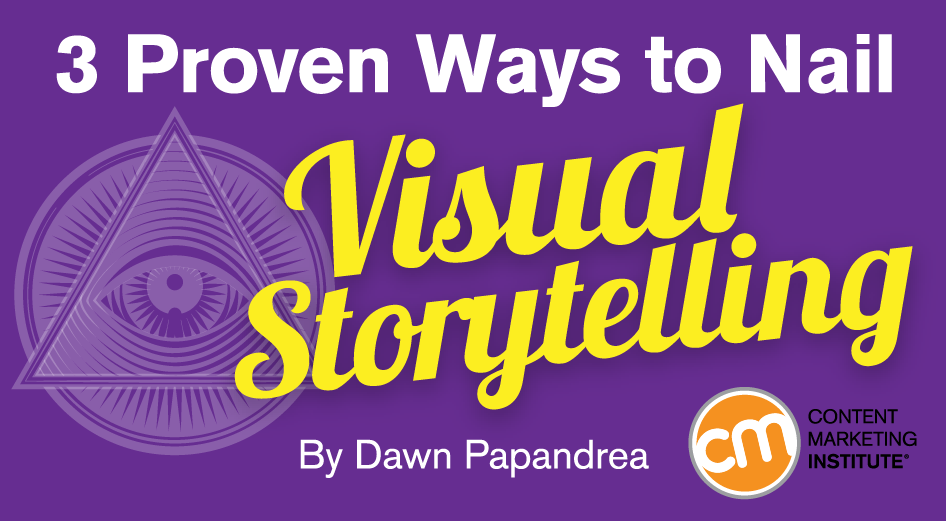Consider this: Your content can generate up to 94% more views if you add compelling visual elements and graphics, according to HubSpot.
To make visual storytelling work, however, you can’t simply slap a few stock photos onto your blog or social media posts. Just as headlines and calls to action must be crafted carefully, your visual content deserves more than a second thought. Your target customers will form their own interpretations and first impressions based on the visuals you choose to put before them. What is your imagery really saying about your brand?
Are you conservative? Futuristic? Freewheeling? Quirky? You can convey all of this through a thoughtful visual brand strategy. A consistent strategy also creates a connective thread, leaving visual bread crumbs across your social, website, blog, etc., for your audience to easily identify you. By including visuals in your marketing, you are adding sensory keys to clue in your audience on what you’re trying to say.
To nail visual storytelling, incorporate these three factors: authenticity, sensory, and relevancy.
Authenticity
If the popularity of selfies and emojis are any indication, we’re a world of visually driven content consumers. That’s why it’s easy for most people to spot fake or poor attempts by brands to capture their attention. Audiences want real, candid moments – not cheesy stock or promotional photos. As a marketer, you want to tap into your audience’s emotions, and say something that is significant and relevant.
“The photograph itself doesn’t interest me. I want only to capture a minute part of reality.”
–Henri Cartier-Bresson, 20th century French photographer
Visually stunning example
Dove’s Real Beauty campaign, which uses diverse “real” women instead of waif-like models, shows that the brand values the beauty of women in all shapes, sizes, and ethnicities. Dove tells a visual story of inclusion. Here is its latest initiative, #speakbeautiful:
Best practices
- Articulate your brand personality. Is it warm and friendly? Sleek and modern? Helpful and familiar? Figure out what colors, designs, and images are authentic to your brand and product.
- Use images or photographs that form a connection with your audience while helping you tell a story. Don’t overload them with pop-culture images, memes, or anything that doesn’t resonate with your brand.
- Track feedback to figure out which visuals resonate with your audience to help guide future visual content. You can do this by A/B testing visuals on social or experimenting with hero images on your website.
Sensory
A good image not only pleases the eye, but it stimulates all the senses. Images go beyond communicating a place or thing – they can create warmth, evoke nostalgia, or instill modernity.
“We’re fatigued by how digital life has become. Our culture has become driven by information overload, but our senses still yearn to be stimulated.” –Pam Grossman, director of visual trends, Getty Images
Visually stunning example
Squarespace, a website creation service, uses sensory-evoking imagery at the heart of its brand content. Can’t you just feel, hear, and smell the images in this video?
Best practices
- Pay attention to images that exhibit textures that seem to jump off the screen, like an up-close shot of coarse wood grain or a lush patch of grass.
- Crop images in a way that interests your audience, draws the eye to the intended focus, and encourages them to learn more. For example, if you’re sharing an inspirational photo of hot air balloons in a wide-angle shot, perhaps the image will be more impactful if you crop away some of the scenery so your eye is immediately drawn to the balloon rising into the sky. Just remember, the cropped image still must be able to stand on its own.
- Play with perspective. Highlighting details and imperfections as well as providing large scenes invites your audience to take both a micro and macro look.
Relevance
We all like to look at photos and videos that are pretty, interesting, moving, or even breathtaking. Even if your imagery hits one of those marks, that doesn’t necessarily make it relevant for your audience. Think about whether an image will speak to your end users and fit in with their values and mindset.
Visually stunning example
Honey Maid received marketing accolades for presenting its visual story on how the definition of “family” has evolved to include biracial, gay, single-parent, and other types of family units. When Honey Maid received backlash, its response was to show the power of love overcoming hate through a beautiful visual – it spelled the word “love” with print copies of negative tweets.
“It’s necessary to take risks, even if they may alienate some of your audience. It’s always good business practice to be progressive and assume that people are going to catch up.” –Pam Grossman, director of visual trends, Getty Images
Best practices
- Take a stand and choose bold images that illustrate your brand values, keeping your key audience in mind.
- Stay relevant by considering the context in which you’re presenting images.
- Be sensitive to cultural moments in time, and be cautious about being overly promotional.
You don’t have to be a natural artist or designer to create a gorgeous visual identity for your brand. Listen to your gut. Go with images that feel relevant and authentic to your brand and your audience, that make you feel things and represent the people with whom you’re trying to connect, and will help you create a winning first impression for your content.
For more visual-content strategies, download our white paper, The Principles of Visual Storytelling.
Looking for more ways to maximize the impact of your visual content? Get practical insights, advice, and answers in our 2018 Guide to Essential Content Marketing Tactics.



